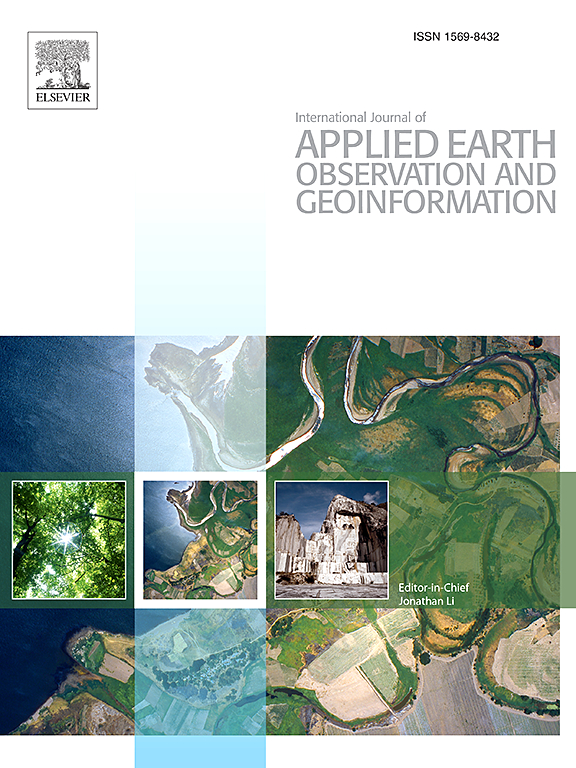气候变化下地形对全球高寒地区植被绿化和面积扩张的影响
IF 7.6
Q1 REMOTE SENSING
International journal of applied earth observation and geoinformation : ITC journal
Pub Date : 2025-07-15
DOI:10.1016/j.jag.2025.104727
引用次数: 0
摘要
位于高山地区林木线以上的高山地带对全球变暖非常敏感。地形调节地表能量、质量和动量通量,从而在很大程度上影响气候变暖下的植被生长。然而,近几十年来,地形对植被变化的影响,特别是在全球尺度上对高寒植被的影响知之甚少。本文利用30 m空间分辨率的Landsat影像,量化了1984-2023年全球高寒生态系统植被绿度和植被面积的变化趋势,并量化了地形对植被变化的影响。我们的研究结果表明,超过99%的全球高寒带呈现同步显著(p <;0.05)植被绿化,增加植被面积。然而,地形对两种植被指标的影响在85.49%的区域存在差异,在这些区域,植被绿化速率的幅度随着海拔的升高而降低,而植被面积的扩张速度随着海拔的升高而加快。植被动态也随坡向变化,与赤道坡面相比,极向坡面植被绿度(72.59%)和植被面积(64.50%)的趋势幅度更高。我们的研究结果提供了全球高寒植被动态的统一评估,并突出了全球气候变化下地形因子对高寒生态系统的复杂影响。本文章由计算机程序翻译,如有差异,请以英文原文为准。
Topographic effects on vegetation greening and area expansion in global alpine zones under climate change
Alpine zones, located above the treeline in high mountain areas, are highly sensitive to global warming. Topography modulates land surface energy, mass and momentum fluxes and thus can largely influence vegetation growth under a warming climate. However, little is known about the topographical effects on vegetation changes during recent decades, especially in alpine vegetation at the global scale. Here we utilize 30 m spatial resolution Landsat imagery to quantify trends in vegetation greenness and vegetated areas during 1984–2023 in global alpine ecosystems and quantify the effects of topography on vegetation changes. Our results reveal that more than 99 % of the global alpine zones show concurrent significant (p < 0.05) vegetation greening and increasing vegetated areas. Yet, the effects of topography on the two vegetation metrics diverge in 85.49 % of the regions where the magnitude of the rate of vegetation greening decreases with higher elevation whereas the expansion rate of vegetated areas is faster with higher elevations. Moreover, vegetation dynamics also covary with the slope aspect, with polar-facing slopes experiencing higher trend magnitude in vegetation greenness (72.59 %) and vegetated areas (64.50 %) compared to the equatorial-facing slopes. Our findings provide a unified assessment of global alpine vegetation dynamics and highlight the complex impacts of topographic factors on alpine ecosystems under global climate change.
求助全文
通过发布文献求助,成功后即可免费获取论文全文。
去求助
来源期刊

International journal of applied earth observation and geoinformation : ITC journal
Global and Planetary Change, Management, Monitoring, Policy and Law, Earth-Surface Processes, Computers in Earth Sciences
CiteScore
12.00
自引率
0.00%
发文量
0
审稿时长
77 days
期刊介绍:
The International Journal of Applied Earth Observation and Geoinformation publishes original papers that utilize earth observation data for natural resource and environmental inventory and management. These data primarily originate from remote sensing platforms, including satellites and aircraft, supplemented by surface and subsurface measurements. Addressing natural resources such as forests, agricultural land, soils, and water, as well as environmental concerns like biodiversity, land degradation, and hazards, the journal explores conceptual and data-driven approaches. It covers geoinformation themes like capturing, databasing, visualization, interpretation, data quality, and spatial uncertainty.
 求助内容:
求助内容: 应助结果提醒方式:
应助结果提醒方式:


